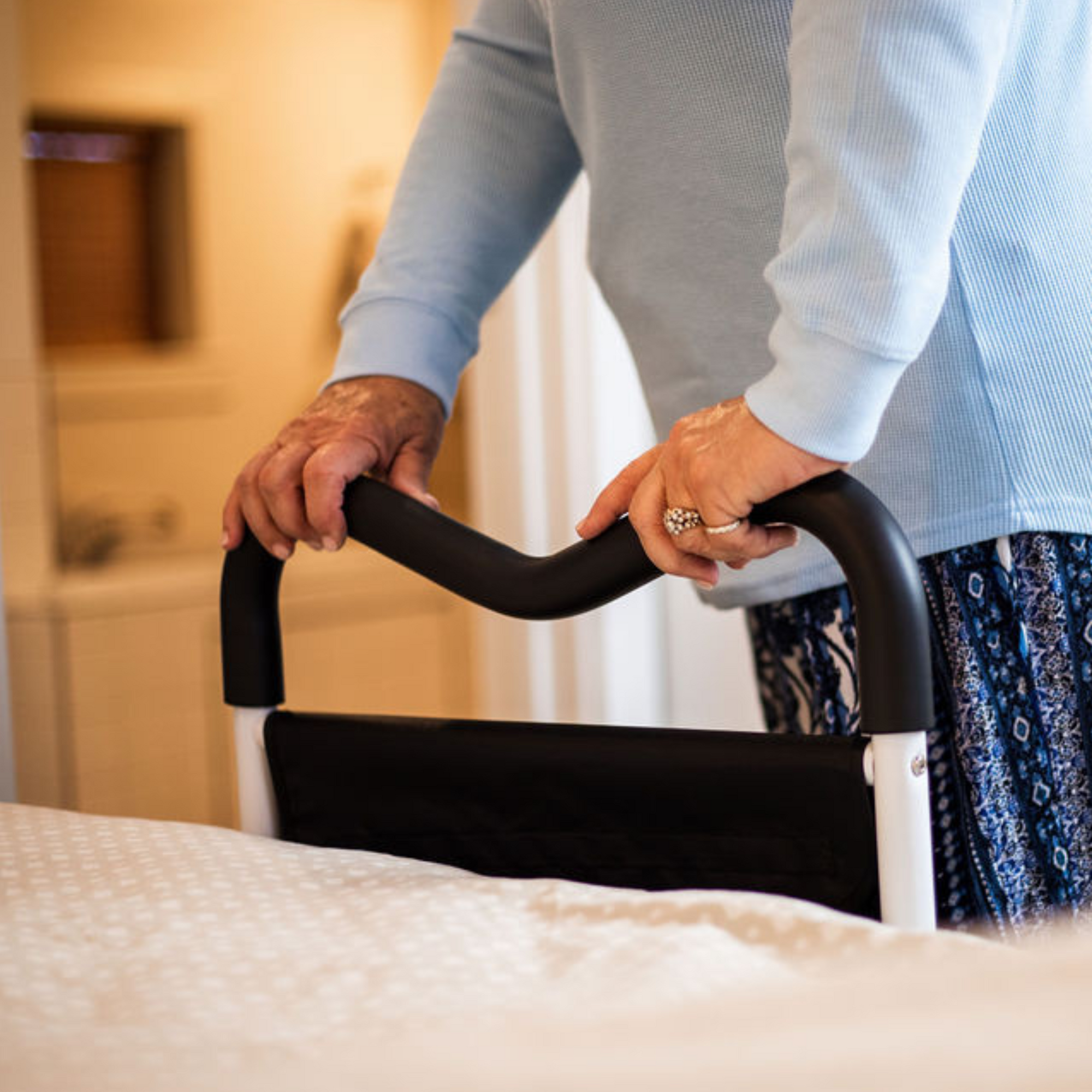Fall prevention is a critical concern for health insurance plans today. With the aging population and an increasing number of falls resulting in injuries, it has become imperative for health plans to take a proactive approach to address this issue.
While many plans have implemented fall prevention education initiatives, they often fall short in achieving significant results in terms of reduced fall risk and member satisfaction. This blog post will explore why that is and why education alone is insufficient to address home safety.
The Home Modification Maturity Curve
The Home Modification Maturity Curve serves as a valuable tool for health plans to assess their progress in creating a fully integrated and mature home safety benefit for their members.
We built this model after having countless conversations with key leaders at plans across the country. We began to notice a common theme among every plan - they desire to build a more proactive home safety benefit but are unsure the exact steps in doing so.
This model outlines a structured journey that plans can undertake to enhance their fall prevention initiatives. It begins at the first, and most unfortunate, stage of having no fall incidents reported or documented. Then eventually advances towards the pinnacle of a comprehensive benefit that includes in-home assessments, data collection, competitive product pricing and most important professional installation - ensuring members are actually receiving the support they need to ensure falls are minimized.
At its core, the maturity curve acknowledges that fall prevention efforts extend beyond mere education. And throughout this article we’ll highlight why education is simply not enough to address the prevalence of falls among your members.

Stage 1: A Need Goes Unnoticed
A significant challenge health insurance plans face is that home safety needs often go unnoticed and unreported. There are several reasons contributing to this issue, but most often times are due to:
- Lack of Awareness: Many members may not recognize potential fall hazards in their homes, and health plans might not routinely inquire about home safety during annual check-ins.
- Underreporting of Incidents: Another critical aspect is the underreporting of fall incidents that do not result in emergency department visits or apparent injuries. Many members might experience near-misses or minor falls but choose not to report them, considering them insignificant or attributing them to clumsiness.
- Normalization of Risks: Some members might perceive certain fall risks as a normal part of aging, leading them to overlook potential hazards in their homes. This normalization of risks prevents them from seeking assistance or making necessary changes to improve home safety.
- Fear of Stigmatization: Some members might hesitate to report fall incidents or express concerns about home safety due to the fear of being perceived as vulnerable or incapable of living independently. This fear of stigmatization can discourage open communication about fall risks.
If plans are not made aware of an incident or concern it is nearly impossible to provide proactive resources to members.
Stage 2: Reactive Education & Outreach
In the second stage of the home modification maturity curve, a plan may finally become aware of a member's need or incident. This progress is a step in the right direction, but it often involves a light handoff of resources & information, where the plan remains removed from what happened, why, and how to prevent the incident in the future.
While this is an improvement compared to the first stage of the maturity curve, it still involves gaps in improving member safety.
The biggest barriers for health plans at this stage are:
- Limited Engagement: Interaction between the plan and the member may be limited to a care manager reaching out or educational materials being sent to the member's home. While these efforts can increase awareness, they may not be sufficient to address the unique and specific factors contributing to the member's fall risk.
- Insufficient Support: Merely providing education or limited interventions might not offer the necessary support for the member to take meaningful action in making their home safer. Behavioral change requires ongoing guidance and encouragement, which may be lacking in this stage.
- Missed Preventive Opportunities: If the health insurance plan is not actively involved in understanding the root causes of the fall and assisting the member in implementing necessary modifications, they miss critical opportunities to prevent future falls and even worse, ED visits or hospitalizations.
Stage 3: Proactive Education Meets Engagement
In stage 3 of the home modification maturity curve, plans may offer more proactive education & a benefit that covers home modifications. Additionally, plans often conduct in-home assessments to gain a deeper understanding of the member's environment and current situation.
While these initiatives represent significant progress and a commitment to member safety, one critical challenge remains – what happens after risks are identified?
This is the stage in which the majority of plans run into the challenge of bridging the gap between education and action. If problems are identified but aren’t solved for then members are just as much at risk as before. Most members are left on their own to source products, find experts who can install those products and then navigate these changes in their daily life at home.
It’s a recipe for inaction.

That's why implementing a full comprehensive home modification benefit that covers procurement of products, installation, and education for members is the only real way to verify that the benefit is utilized and ensure an ROI. However this type of hands-on benefit can be a major undertaking for health insurance plans.
Several challenges can hinder a plan’s ability to offer such a comprehensive program. This includes:
- Coordination and Partnerships: Offering a comprehensive home modification benefit requires coordination with multiple external partners, including product suppliers, home modification service providers, and education experts. Establishing and managing these partnerships can be time-consuming and administratively challenging. Moreover, ensuring consistency and quality across different regions and service providers can be difficult.
- Time Constraints: Implementing a comprehensive program can be a time-consuming process. Health insurance plans need to allocate resources for program development, stakeholder engagement, and training. Limited timeframes and competing priorities within the organization may impede the quick rollout of such initiatives.
- Geographical Challenges: Health insurance plans often operate in diverse geographical regions, each with unique home modification needs and local service providers. Ensuring uniform access to comprehensive home modification benefits across different locations can be logistically complex.
If you’re interested in learning more about how Jukebox Health and full benefit administrative platform solves for each of these problems please reach out to connect with our team. We’d be honored to provide you with a full demo of our services. Contact us at hello@jukeboxhealth.com or call us directly at (212) 321-5113.
The Missing Key for Plans
In the quest to develop a truly comprehensive home safety benefit, plans must recognize the vital role that installation plays in ensuring the successful implementation of home modifications.
While providing members with resources (and even products) for home modifications is a step in the right direction, it is installation that transforms these resources into tangible, effective safety measures. Installation is not only important but also clinically necessary, as it ensures that members have the opportunity to fully integrate safety modifications into their daily lives at home.
Installation is such a crucial part of providing a home modification benefit and it’s why we’ve dedicated extensive time and resources to building a national network of vetted installers. These installers work directly with our team to ensure every product is installed accurately and timely.
There are three major benefits to leveraging a pre-built installer network.
Addressing The Complexities of Home Modifications:
Home modifications are not a one-size-fits-all solution.
Each member's living situation, mobility challenges, and safety needs are unique. Installing grab bars, handrails, or other adaptive devices require specialized knowledge to ensure they are properly placed, secure, and effective. Installers that leverage thorough work orders and have home modification experience are able to understand the complexities involved in adapting homes for safety. This minimizes future grievances.
Clinical Necessity:
Home safety is not just a matter of convenience; it is a critical aspect of preventive healthcare.
Falls in the home are a leading cause of injuries and hospitalizations. By providing professional installation services that follow the specific instructions of the clinician who conducted the home assessment, health insurance plans can ensure that modifications are executed correctly, significantly reducing the risk of accidents and injuries.
Maximizing Utilization and Effectiveness:
Providing members with home modification resources without installation assistance leaves room for uncertainty and implementation challenges. Many members may lack the skills or confidence to carry out installations themselves, leading to potential delay, incorrect installations or no installation at all.
A grab bar is useless if it stays in the box it originally came in.
Helping Your Plan Go The Next Step
In the pursuit of reaching the top level of the home modification maturity curve, plans require a comprehensive solution that addresses the common challenges that have historically held them back from building an effective fall prevention benefit.
We believe that our services & technology sets us apart as a reliable home safety partner. From product procurement, to competitive pricing, and a vetted network of occupational therapists (OTs) and installers we are ready to help your plan go the next step and build an effective & highly utilized home safety benefit.
To receive a demo of our services and learn more about how Jukebox Health can help your plan build a thorough home safety program contact our partnership team at hello@jukeboxhealth.com or call us directly at (212) 321-5113.







